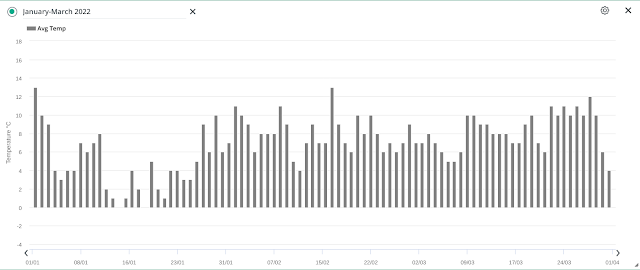The first asparagus spear of 2023 was spotted on the 10th of April ...
 |
| Photo 1: Asparagus Spears (April 10th 2023) |
... which was a few days earlier than 2022. However, in 2021, the first spears appeared nearly 2 weeks earlier at the end of March.
When the first asparagus spears emerge after their winter dormancy is dependent on the soil temperature as it warms up in late winter/early spring. Asparagus requires a soil temperature of at least 10 ℃, or maybe 5 ℃, for the shoots to start growing. I measured the soil temperature on the 18th April, after the emergence of several spears, using my well-used soil/compost thermometers (Photo 2). The larger dialled thermometer is measuring soil temperature at 30 cm depth (~ 9 ℃) and the smaller one at 10 cm (~13 ℃).
 |
| Photo 2: Measuring soil temperature of the asparagus plot |
The asparagus crowns were originally planted at a depth of about 20 cm. If I'd thought about a bit more then I would have started measuring the soil temperatures earlier in the season - maybe next year?!
Clearly, soil temperatures are now sufficient for the asparagus patch to start its productive phase.
The first appearance of an asparagus spear at this location (assuming the variety does not change) could be an example of a phenological measurement. At the moment, I only have three data points (2021, 2022 and 2023) so insufficient information to make any inferences - and not for a good number of years unless the climate undergoes some very rapid changes.
Nevertheless, in the absence of a time series on soil temperatures (ideal option), it might be possible to discern some patterns by looking at weather parameters that might reasonably affect soil temperature. For example, air temperatures (including daily/weekly/monthy minimum/maximum/average temperatures), sunshine hours, rainfall, wind speed/direction.
Looking first at mean (average) daily temperatures for the period January 1st to March 31st for each of the three years (2021-2023) - see Figures 3 - 5. Nothing in particular jumps out from the temperature profiles. 2022 had the more consistent temperature profile with fewer 'frosty' dips but also had the latest date for spear emergence. 2021 was the earliest by some distance with perhaps the most stable high March temperatures plus extra warmth at the end of that month - maybe that extra warmth was just enough to bring the early shoots to the surface.
 |
| Figure 3: Daily Average Temperatures for Jan-Mar 2021 |
 |
| Figure 4: Daily Average Temperatures for Jan-Mar 2022 |
 |
| Figure 5: Daily Average Temperatures for Jan-Mar 2023 |
We shall consider sunshine next as this has a warming effect on the soil (Figures 6 -8). March 2021 ended with high average temperatures (Figure 3) and strong sunshine values (Figure 6) - both helpful for soil warming. However, March 2022 was sunnier than March 2023 despite the latter having an earlier appearance of asparagus spears.
 |
| Figure 6: Daily Solar Radiation Values for Jan-Mar 2021 |
 |
| Figure 7: Daily Solar Radiation Values for Jan-Mar 2022 |
 |
| Figure 8: Daily Solar Radiation Values for Jan-Mar 2023 |
Other temperature data (e.g. minimum daily) shows no obvious relationship with the first appearance date of asparagus shoots. Well, that will not stop us enjoying the first taste of asparagus this year - albeit, a rather small taste since this is the only spear available at this moment!!
 |
| Photo 3: First Asparagus Ready for Cutting (19/4/23) |






0 comments:
Post a Comment